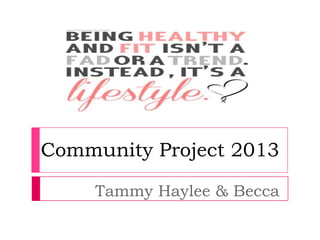Community project 2013
- 1. Community Project 2013 Tammy Haylee & Becca
- 2. Biometrics Screening Summary Report: Old Fashion Days 2013 Total clients tested: 63 ÔÅΩ ÔÅΩ ÔÅΩ ÔÅΩ ÔÅΩ # with total Cholesterol > 200 24% of total 38 # With HDL <20 15% of total 24 # with Blood sugar >140 4% # with A1C > 6.0% 7% of total 11 # with BP > Stage 1 (140/90) 12% of total 19
- 3. What is Diabetes? ÔÅΩ ÔÅΩ Type 1 diabetes. Type 1 diabetes is an autoimmune disease in which the body's immune system destroys the cells in the pancreas that produce insulin, resulting in no or a low amount of insulin. People with type 1 diabetes must take insulin daily in order to live. Type 2 diabetes. Type 2 diabetes is a result of the body's inability to make enough, or to properly use, insulin. Type 2 diabetes may be controlled with diet, exercise, and weight loss, or may require oral medications and/or insulin injections.
- 4. Diabetes Cont. ÔÅΩ Gestational diabetes mellitus (GDM). Gestational diabetes mellitus GDM) occurs in pregnant women who have not been diagnosed with diabetes in the past. It results in the inability to use the insulin that is present effectively and it usually disappears after delivery. GDM may be controlled with diet, exercise, and attention to weight gain. Women with GDM may be at higher risk for type 2 diabetes later in life.
- 5. A1C Test for Diabetes Control ÔÅΩ ÔÅΩ ÔÅΩ This is a blood test used to determine the average blood sugar control over the past 2 or 3 months. The A1C rises as your blood sugar rises. The normal ranges for a person with out diabetes is 4 to 6% ÔÅΩ ÔÅΩ The goal for most adults with diabetes is an A1C at or below 7% The higher your A1C the greater your risk of diabetes related problems.
- 6. Diabetes Facts ÔÅΩ African-Americans are two times more likely to develop diabetes than white Americans. ÔÅΩ Diabetes is the fifth leading cause of death among AsianAmericans and Pacific Islander Americans between ages 45 and 64. ÔÅΩ African-Americans are more likely to undergo lowerextremity amputations due to complications of diabetes than white Americans or Hispanic Americans.
- 7. What is Cholesterol?  Cholesterol is a fatlike, waxy substance that can be found in all parts of your body. It aids in the production of cell membranes, many hormones, and vitamin D. The cholesterol in your blood comes from two sources: the foods you eat and your liver. However, your liver makes all the cholesterol your body needs What is a healthy Cholesterol level?  LDL—less than 100 milligrams per deciliter (mg/dl) is considered desirable  HDL—greater than 40 milligrams per deciliter (mg/dl)  A total cholesterol level below 200 mg/dl is considered desirable
- 8. Improving Your Cholesterol Lowering LDL or “Bad Cholesterol”  Eat more leafy greens, fish, whole grains, whole grains fruits and vegetables.  Eat less red meat, whole milk, full fat cheese and saturated fats.  Exercise Raising HDL or “Good Cholesterol”  Eat a palm full of almonds or black walnuts 3 times a week.  Switch to cooking with olive oil.  Eat salmon or tuna 2 or more times a week.  Exercise.  Avoid Tobacco Smoke.
- 9. Cholesterol cont. Lowering Triglycerides or Fat ÔÅΩ Eat flax seeds or use flax seed oil. ÔÅΩ Eat dark, green leafy vegetables. ÔÅΩ Eat soy products like soy milk. ÔÅΩ Eat more fish, like salmon, tuna, mackerel, tr out, and sardines. ÔÅΩ Avoid foods with trans fats like fast food and processed foods.
- 10. What is Blood Pressure? ÔÅΩ ÔÅΩ Blood pressure is the force of blood against the walls of your arteries. High blood pressure can be controlled with lifestyle changes like being smokefree, getting 150 minutes of physical activity a week, eating a balanced diet, and managing stress.
- 11. Ohio Risk Factors According to 2007 Behavioral Risk Factor Surveillance System (BRFSS) survey results, adults in Ohio reported having the following risk factors for heart disease: ÔÅΩ ÔÅΩ ÔÅΩ ÔÅΩ ÔÅΩ ÔÅΩ ÔÅΩ 28.4% had high blood pressure 39.6% of those screened reported having high blood cholesterol 9.5% had diabetes 23.1% were current smokers 63.5% were overweight or obese (Body Mass Index greater than or equal to 25.0) 50.0% reported no exercise in the prior 30 days 79.2% ate fruit and vegetables less than 5 times a day More than 1 out of 4 deaths in Ohio are due to heart disease.
- 12. Helping Your Heart Five Simple Steps: 1) Don’t smoke or use tobacco 2) Exercise 30 minutes a day. 3) Eat a heart-healthy diet 4) Maintain a healthy weight 5) Get regular health screenings












